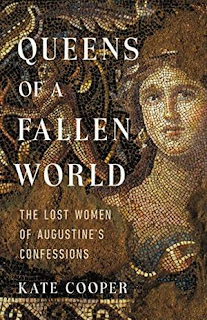Browsing in Barnes and Noble recently, I came across a strangely titled book, Queens of a Fallen World: The Lost Women of Augustine’s Confessions (Basic Books, 2023), by Kate Cooper, Professor of History at Royal Holloway, University of London. So strange did that title seem that I might easily have passed it by, had I not noticed the blurb on the back cover by esteemed historian and Augustine scholar Peter Brown, who labeled it a « masterpiece of the historian’s art » and « a rare balance of state-of-the-art erudition and felicitous hypotheses. » That was hard to resist. Thanks to Brown, I bought the book. Once opened, it was hard to close.
That said, its title is still somewhat strange. It is really a book about Augustine and the important part played by two women in particular – his mother Monica (obviously) and the unnamed woman who was the mother of his son Adeodatus, whom Cooper calls Una. Ostensibly the book aims to highlight four women – the Empress Justina and Augustine’s unnamed betrothed, whom Cooper calls Tacita, in addition to Monica and Una. In fact, however, Empress Justina and 10-yer old Tacita, are themselves personally much less significant than either Monica or Una.
The book’s biographical accounts of the Empress Justina and Saint Monica is interesting, as are the author’s much more speculative treatments of the less well documented lives and circumstances of the two unnamed women in Augustine’s story. In my judgment, however, the book’s major contributions are its detailed analysis of Roman marriage laws and customs, its speculations concerning their eventual effect on Augustine and his « conversion, » and his consequent commitment as a Catholic Bishop to a new theology of marriage.
In our current ritualization of Christian marriage, we still practice the Roman dextrarum iunctio (the joining of the right hands) and we still require the consent of the parties; but, in other important respects, Roman marriage (even among 4th-century Christians) was quite different from how we understand Christian marriage today. Marriage between free Roman citizens « cemented a reproductive collaboration between two separate families, establishing a secure answer to questions about property – that is, which among a man’s biological offspring could claim rights as his heirs. » Concubinage, in contrast, which normally involved a relationship with someone of lower status (a slave or a freedwoman), was not about producing heirs. In fact, « it was seen as entirely honorable for a man to have children whom he did not intend to support. »
As anyone familiar with Augustine’s story knows, Augustine’s parents had not arranged a suitable marriage for their son when he was young, presumably in expectation that a better marriage might be arranged later with a family with wealth and connections which would advance Augustine’s career. That was all a perfectly normal and respectable aspiration in that culture. In the meantime, the young Augustine took a concubine, with whom he eventually had a son, Adeodatus. This was also a perfectly normal and respectable thing to do in that society. Later, when they were all settled in Milan, Monica sought the sort of marriage which would be financially advantageous for Augustine, and an engagement with a 10-year old heiress was appropriately arranged. Thanks to what Cooper calls « the unquestioned cruelty of the Roman approach to family life, » Augustine was inevitably expected to end his relationship with the mother of his son. He did so, and she duly returned to Africa. But neither Monica nor her ambitious, upwardly mobile son « seems to have grasped what it would cost him to put the plan into action. » Cooper argues that Augustine « had failed to anticipate the agony caused by severing the deep emotional bonds of a long life together – a life that he, at least, had found unusually happy. »
Here Cooper gets somewhat speculative. She highlights how « really it was money, not sexual renunciation, that loomed large at the center of the debate » between Augustine and Alypius at that point in the Confessions. In her very plausible reading of Augustine’s Confessions, « the received view is not wrong that Augustine was recoiling from sin when he decided not to marry. But the sin that repulsed him was not lust; it was greed. » She argues that breaking his engagement « was not a rejection of sex but a revelation about money and loyalty – a refusal to sell himself, a desire to live up to the implicit if unspoken promise that he now saw he had made to Una. »
For those whom Cooper calls « civic-minded bishops, » like the celibate Augustine and his happily married friend Paulinus, Bishop of Nola, « the outsized craving that was most spiritually dangerous was not lust but the love of money. »
As a bishop, Augustine famously « would argue that a man who had lived with a concubine should not be allowed to marry, » that (contrary to Roman law and custom) « the church should see the union as spiritually equivalent to marriage, » and « that in moral terms an established extramarital relationship carried the same responsibility as the legal bond of marriage. » Influenced by his own intensely lived experience, Augustine as a bishop moved the Church’s thinking about marriage away from its classical Roman expression and into a radically new and more egalitarian direction.
Augustine’s reframing of the Church’s appreciation of marriage is well known. What is so interesting and illuminating in Cooper’s approach is the emphasis she places on Augustine’s personal relationship with the woman Cooper calls Una. That Augustine condemned greed as a sin is hardly a new discovery. But the connection Cooper highlights between greed and the institutional arrangements surrounding Roman marriage and concubinage represents a genuine insight of perennial importance.
The legal and social structures of marriage have changed since Augustine’s time, but the phenomenon of men dumping a long-time partner for a younger « trophy wife » or an otherwise advantageous new match remains still very real in today’s late capitalist world, where we are again being pressed to recognize the insidious power of greed and its corrupting effect upon all social institutions. This recognition ought to incentivize us to reprioritize the sins which undermine our moral capacities, our social commitments, and (a new issue) our care for our common home, as Pope Francis calls our environmentally challenged planet.




